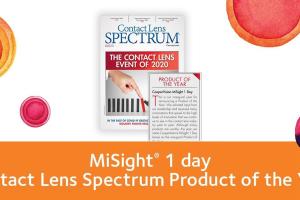by Tiffany Yanese Park

There is no denying that the ways children use their eyes have shifted significantly in the recent decades. There appears to be a parallel with these behaviors to the rising numbers of children affected by myopia. An abundance of concern circle around screen time specifically. These discussions boil down to the significance of
- the viewing distance: is there a difference between watching or reading something up close versus far away?
- the duration: how long is the child focusing?
To understand the context of the consequences of near work on the eye, the workings of the eye’s accommodative system should be reviewed. For a distant target to be perceived as clear, it must be exactly focused onto the retina. When the viewing distance shortens, the natural lens of the eye typically preserves this focus by flexing or relaxing. If the focus is inaccurate or latent, the image will not land on the retina, resulting in blur. Imprecise focus, or accommodative lag, is not a characteristic exclusive to children with myopia, so its significance is debatable (1-3). However, there appears to be a link between sustained near work and accommodative retention, leading to latent or transient myopia (4). Successive cycles of near work induced transient myopia can create a net defocus and presumably stimulate axial elongation (5). This has been demonstrated in children with emmetropia and hyperopia, but most prominently in those with myopia (6,7). Children’s prolonged near work continues to be a topic of critical examination and is implicated as a contributor to myopia progression (8).
How close is too close?
We know that children’s eyes usually have an impressive ability to accommodate as compared to those of adults. The average amplitude of accommodation for a child is about 14 diopters (9), meaning children can hold things about 3 inches from their eyes and could potentially still see it crispy clear! That is awfully close and not typical for most children, however parents have become increasingly worried about close reading and watching distances for their children. Multiple studies have pinpointed working distances shorter than 20 to 30 centimeters as an increased risk for myopia (10-14). For context, that is nearly equivalent to the dimensions of a piece of paper! But screen time cannot be singled out to be criticized. Whether the viewing target is a coloring book, a novel or a phone, it is the working distance that seems be problematic, which connects the involvement of the accommodative system (13, 15-19). A parent’s intuition for a child to scoot back is valid!
Interestingly, the studies that included television watching had a less definitive correlation to myopia. Some showed no relationship or an inverse relationship between the activity and myopia (15,16,20-22). Children may be overjoyed to know this at first glance, but most authors admit there is unlikely a true protective effect of watching television. Rather, the complex accommodative system is not stimulated or there is a substitution effect of less time spent using their eyes at closer working distances. Before handing the remote back to their children, parents should instead consider heading outdoors (hyperlink to “What Makes The Great Outdoors Great? Peering More Into Select Environmental Risk Factors For Myopia”).
How much time is too long?
The intensity of near work has been another area of high concern. Not only is viewing distance a pertinent factor in near work behaviors, but also the time spent. Total weekly use of 3 to 4 hours (23, 24) and a range of 20 minutes to one hour of continuous near work have been associated with myopia (23, 25). Those findings may cause dismay, because frankly some children can easily exceed those time limits in a single day. Parents can have reassurance that time outdoors can dampen this repercussion of near work (25-27). With the future of virtual schooling uncertain, it is even more imperative that parents be mindful of the extracurricular ways children are using their eyes. Recommendations have been made that children take a break every 30 minutes to be outdoors (13, 26), as continuous time spent with near work may have an even stronger effect than cumulative time (11, 13).
In Summary
Children’s vision demands inherently change with age, as they go through higher school grades and have less time or interest to play outside (24). With all of this in mind, parents should be aware of how certain aspects of near work habits such as working distance and duration influence their child’s eyes. The simplified “20-20” adage propagated by the eye care community seems to have some bearing: after 20 minutes, look 20 feet away. Making deliberate daily modifications can chip away at a child’s risk of myopia and its progression.
References
1. Weizhong L ZY, Wen L, et al. A longitudinal study on the relationship between myopia development and near accommodation lag in myopic children. Ophthalmic Physiol Opt. 2008;28(1):57-61.
2. Koomson NY AA, Opoku-Baah C, et al. Relationship between Reduced Accommodative Lag and Myopia Progression. Optom Vis Sci. 2016;93(7):683-91.
3. Langaas T RP, Svarverud E et al. . Variability of the accommodation response in early onset myopia. Optom Vis Sci. 2008;85(1):37-48.
4. Ciuffreda KJ LM. Differential refractive susceptibility to sustained nearwork. Ophthalmic Physiol Opt. 2002;22(5):372-9.
5. Ciuffreda KJ VB. Nearwork-induced transient myopia (NITM) and permanent myopia — is there a link? Ophthalmic Physiol Opt. 2008;28(2):103-14.
6. Lin Z VB, Lian YB et al. The association between nearwork-induced transient myopi and progression of refractive error: A 3-year cohort report from Beijing Myopia Progression Study. J Optom. 2021;14(1):44-9.
7. Lin Z VB, Lian YB et al. Baseline characteristics of nearwork-induced transient myopia. Optom Vis Sci. 2012;89(12):1725-33.
8. Huang H-M CD-T, Wu P-C. The Association between Near Work Activities and Myopia in Children - A Systematic Review and Meta-Analysis. PloS one. 2015;10(10):e0140419.
9. Castagno VD VM, Meucci RD, Resende DPM, Schneid FH, Getelina R, Nasiloski MR, Fassa AG. Amplitude of Acommodation in Schoolchildren. Curr Eye Res. 2017;42(4):604-10.
10. Wen L CY, Cheng Q, Li X, Pan L, Li L, Zhu H, Lan W, Yang Z. Objectively measured near work, outdoor exposure and myopia in children. Br J Ophthalmol. 2020;104(11):1542-7.
11. Group ACES. Near Work Related Parameters and Myopia in Chinese Children: The Anyang Childhood Eye Study. PloS one. 2015;10(8):e0134514.
12. Quek TPL CC, Chong CS, Chong JH, Hey HW, Lee J, Lim YF, Saw S-M. Prevlance of refractive errors in teenage high school studnets in Singapore. Ophthalmic Physiol Opt. 2004;24(1):47-55.
13. Ip JM SS-M, Rose KA, Morgan IG, Kifley A, Wang JJ, Mitchell P. Role of near work in myopia: findings in a sample of Australian school children. Invest Ophthalmol Vis Sci. 2008;49(7):2903-10.
14. Guo L YJ, Mai J, Du X, Guo Y, Li P, Yue Y, Tang D, Lu C, Zhang W-H. Prevalence and associated factors of myopia among primary and middle school-aged students: a school-based study in Guangzhou. Eye (Lond). 2016;30(6):796-804.
15. Czepita M KL, Safranow K, Mojsa A. The role of reading, writing, using a computer, or watching television in the development of myopia. J Ophthalmol. 2016;1(2):53-7.
16. Czepita M CD, Lubinski W. The Influence of Environmental Factors on the Prevalence of Myopia in Poland. J Ophthalmol. 2017:5983406.
17. Guan H YN, Wang H, Boswell M, Shi Y, Rozelle S, Congdon N. Impact of various types of near work and time spent outdoors at different times of day on visual acuity and refractive error among Chinese school-going children. PloS one. 2019;14(4):e0215827.
18. Harrington SC SJ, O’Dwyer V. Risk factors associated with myopia in schoolchildren in Ireland. Br J Ophthalmol. 2019;103(12):1803-9.
19. Lin Z VB, Mao GY, Ciuffreda KJ, Jhanji V, Li XX, Zhou HJ, Wang NL, Liang YB. The influence of near work on myopic refractive change in urban students in Beijing: a three-year follow-up report. Graefes Arch Clin Exp Ophthalmol. 2016;254(11):2247-55.
20. Parssinen O KM, Viljanen A. The progression of myopia from its onset at age 8-12 to adulthood and the influence of heredity and external factors on myopia progression. A 23-year follow-up study. Acta Ophthalmol. 2014;92(8):730-9.
21. You QS WL, Duan JL, Luo YX, Liu LJ, Li X, Gao Q, Wang W, Xu L, Jonas JB, Guo XH. Factors associated with myopia in school children in China: the Beijing childhood eye study. PloS one. 2012;7(12):e52668.
22. Liu S YS, Xi W, Zhang X. Electronic devices and myopic refraction among children aged 6-14 years in urban areas of Tianjin, China. Ophthalmic Physiol Opt. 2019;39(4):282-93.
23. Lyu Y ZH, Gong Y, Wang D, Chen T, Guo X, Yang S, Liu D, Kang M. Prevalence of and factors associated with myopia in primary school students in the Chaoyang District in Beijin, China. Jpn J Ophthalmol. 2015;59(6):421-9.
24. French AN MI, Mitchell P, Rose KA. Patterns fo myopigenic activities with age, gender, and ethnicity in Sydney schoolchildren. Ophthalmic Physiol Opt. 2013;33(3):318-28.
25. Enthoven CA PJ, Verzijden T, Tideman JWL, Al-Jaffar N, Jansen PW, Raat H, Metz L, Verhoeven VJM, Klaver CCW. Smartphone use associated with refractive error in teenagers: the myopia app study. Ophthalmology. 2021;S0161-6420(21):00518-2.
26. Huang PC HY, Tsai CY, Tsai DD, Chen CW, Hsu CC, Huang SC, Lin MH, Liou YM. Protective behaviours of near work and time outdoors in myopia prevalence and progression in myopic children: a 2-year prospective population study. Br J Ophthalmol. 2020;104(7):956-61.
27. Saxena R VP, Tandon R< Pandey RM, Bhardawaj A, Gupta V, Menon V. Incidence and progression of myopia and associated factors in urban school children in Delhi: The North India Myopia Study (NIM Study). PloS one. 2017;12(12):e0189774.








